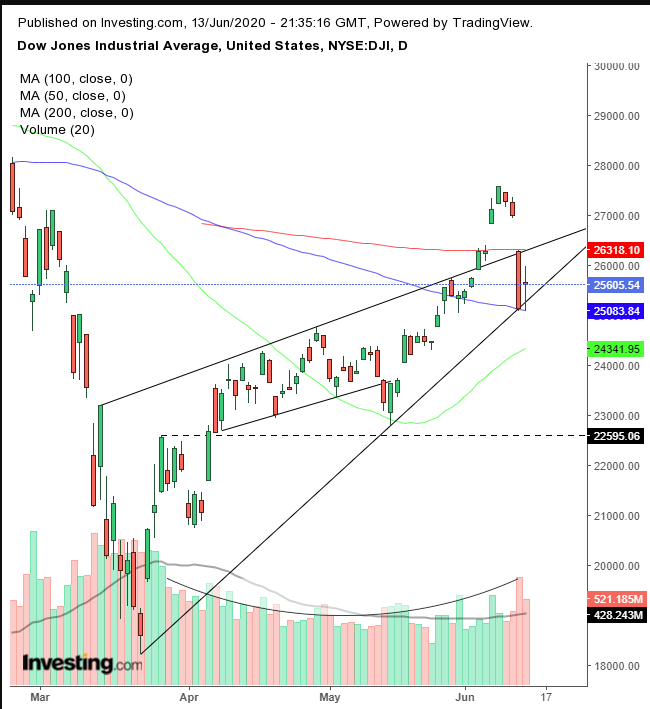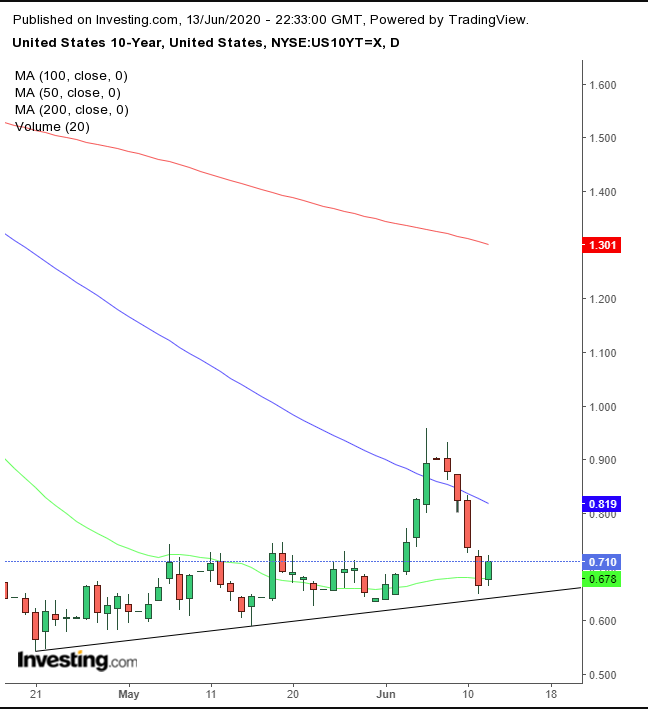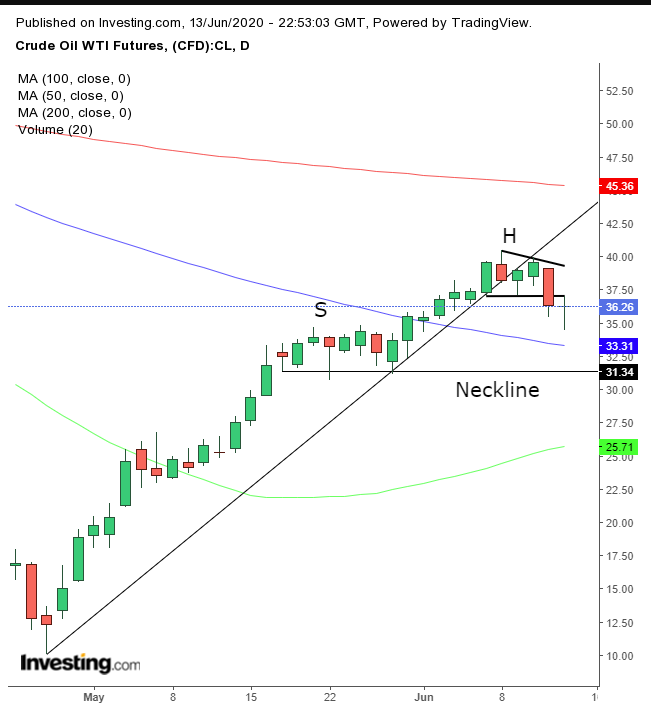- After weeks of ignoring second wave warnings, investors late last week suddenly decided to pay attention
- Potential second wave activity accelerates in US, China
- Gold sees best week in the past ten
Though US equity indices bounced back on Friday after their worst selloff in 12 weeks, fears continue to build that the hoped for, rapid recovery following months of US economic inactivity won't be as quick as some anticipate. As well, a second wave of COVID-19 cases seems to be accelerating.
Over the past few days, Oklahoma and Arizona were among US states to report record increases in new COVID-19 cases, a month after loosening their lockdowns. On Saturday, Florida reported its own record increase of confirmed cases, 2,581.
Also on Saturday, China closed the largest wholesale food market in Beijing and placed the surrounding neighborhood in a fresh lockdown after 50 new coronavirus cases were reported in the country’s capital.
Officials at the US Centers for Disease Control and Prevention have said that states and cities will return to shutdowns if the number of cases rise significantly, which paints an uncertain picture for both the economy and upcoming trading week.
Equities Moved Higher On Friday, But Lost For The Week
As the trade came to a close this past week, bargain hunters took advantage of discounts on stocks that were the hardest hit in Thursday’s plunge. Sectors including Real Estate, (+3.2%), and beleaguered shares of Financials (+3%) and Energy, (+2.5%), outperformed the broader S&P 500 Index.
Cruise companies and airlines shot up. But the moves weren’t one-sided. After opening 2.1% higher, the benchmark index retraced Thursday’s lows and notched a new low as the World Health Organization warned of the risk of a second wave of the pandemic for countries ending lockdowns. However the index later reversed and closed into gains.
Even with Friday’s rebound, all four major indexes—the Dow Jones, NASDAQ Composite, Russell 2000 as well as the S&P 500—dropped for the week. Investors appear to be surprised about both the lingering economic damage and the appearance of a second COVID-19 wave, but there have been ample warnings of both possibilities, including in some of our previous posts.
We have also discussed at length that the economy has no sustainable upward growth path without a medical solution to COVID-19, whether a vaccine or other form of treatment. We've also referred to the 1918 Spanish Flu pandemic which lasted until 1920. The first winter in which it appeared was just an introduction; the second wave, during the following winter, was much deadlier. At that time, there were four waves, infecting 500 million people, a third of the world’s population. It's still considered to be one of the deadliest pandemics in human history.
Though we're more than 100-years on from the Spanish Flu outbreak, the current similarities in terms of world-wide infection make the previous pandemic instructive. As such, we expect market volatility to be with us for some time as investors waver between hope and immediate reality.

On Thursday, ahead of the US session, we said the Dow's June 5 upside gap was concerning, as it might be an Exhaustion Gap and a setup for an Island Reversal. Since then, both the S&P 500 Index and the Dow Jones Industrial Average completed Island Reversals.
While it’s noteworthy that Thursday’s plunge, as well as Friday’s retest, found support at the bottom of the rising wedge, the risk is still to the downside. An Island Reversal demonstrates exhaustion. However, it’s only a short-term bearish signal.
A fall below 22,500 for the DJIA would put us back on track for the rising wedge’s original bearish posture. Nonetheless, only a fall below the March lows would establish a long-term downtrend.
The current market narrative is that Federal Reserve Chairman Jerome Powell’s comments last week, warning of a long-lasting economic impact from the coronavirus is what spurred the selloff. That's odd, considering that Powell delivered that same warning months ago, as did the IMF and other institutions and economists.
And yet investors just kept driving stocks higher, even in the face of devastating economic data. Now, ironically, when data has started bouncing back, and with nothing new pointing to additional chances of economic collapse, investors have become nervous. Perhaps, as we suggested in our earlier post about the Dow Jones, demand has simply dried up.
Treasuries, including for the 10-year benchmark, just about recouped all losses from the recent selloff.

Yields had fallen to a two-week low but found support at the rising trendline since April 20.
The dollar saw its first back-to-back gains since May 22 on Friday.

The global reserve currency had completed an hourly H&S bottom. This was the USD’s first weekly advance in four, producing a long-legged hammer that found support by the 200 DMA, realigning with the March lows. After the symmetrical triangle achieves its implied target, we expect an advance.
Gold jumped 3.2% last week.

It was the best performance for the precious metal since it gained 6.5% in the week starting April 6, when it completed a H&S pattern. The yellow metal also had its best week in ten, and its first weekly advance in four, despite the dollar also seeing a weekly gain in the same period.
Recently gold has been negatively correlated with equities. Does that mean if the commodity actualized the implied targets of its H&S and symmetrical patterns it might occur as equities sold off? Only time will tell.
Oil finished last week up 0.39%

What could have been a continuation pattern has been fizzling out, closing below the would-be bullish pattern for two days in a row. The 200 DMA looms above, as the price crossed below its uptrend line since late April, while the 50 DMA is rushing to realign from below and the 100 DMA realigns from above what may become the neckline of a H&S top.
Week Ahead
All times listed are EDT
Sunday
22:00: China – Industrial Production: expected to have risen to 5.0% in May, from 3.9%.
Monday
8:30: US – NY Empire State Manufacturing Index: anticipated to have moved higher in June, to -27.50 from -48.50 previously.
21:30: Australia – RBA Meeting Minutes
Tuesday
2:00: UK – Claimant Count Change: forecast to tumble to 370.0K from 856.6.
5:00: Germany – ZEW Economic Sentiment: seen to have risen 60.0 from 51.0.
8:30: US – Core Retail Sales: probably recovered to 5.1% from -17.2% in April.
Wednesday
2:00: UK – CPI: predicted to retreat to 0.5% from 0.8% YoY.
5:00: Eurozone – CPI: likely to have remained flat at 0.1%.
8:30: US – Building Permits: expected to have climbed to 1.248M from 1.066M.
8:30: Canada – Core CPI: likely to have risen to 0.1% from -0.4% previously.
10:30: US – Crude Oil Inventories: forecast to plummet to -1.738M from a lofty 5.720M.
Thursday
7:00: UK – BoE Interest Rate Decision: anticipated to remain at 0.10%.
8:30: US – Initial Jobless Claims: expected to come in at 1,300K after last week's 1,542K.
8:30: US – Philadelphia Fed Manufacturing Index: likely to have surged to -25.0 from -43.1.
Friday
2:00: UK – Retail Sales: seen to jump to 5.8% from -18.1%.
6:30: Russia – Interest Rate Decision: expected to be cut to 5.00% from 5.5%.
8:30: Canada – Core Retail Sales: probably fell to -12.8% from -0.4%.
